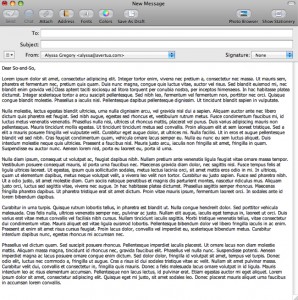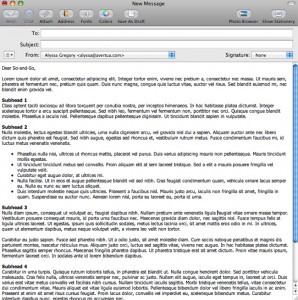How much time do you spend managing e-mail every day? If you’re like me, you may feel like it’s too much time, even if you have the process nailed down. It seems e-mail can be a major productivity drain, but it’s one of those elements of business that is not going away.
Not only are there certain things to avoid in following e-mail etiquette rules, but there are things you can do to streamline your messages even more. And this will not only save yourself time and energy, but it will make reading and responding to your messages easier for your recipients. Here are some ideas.
Make It Easy to Follow
As much as we try to keep e-mails short and to the point, some need the bulk and there’s no way around it. One way to make your longer messages easier to follow is by using subheads and bulleted lists to break up the text. This also helps the reader zero in on the most important topics and gives them a way to jump to a specific part of the long e-mail later on. See the example below of straight text compared to being broken up by subheads and bullets.

 Identify Action Items
Clearly identify specific action items and questions for the recipient by highlighting, numbering or marking them in some other easy-to-notice way (keep in mind that the e-mail client used by your recipient may not support all options). Not only will this help the recipient keep track of what actions they need to take or questions they need to answer, but it will help you get a more complete response on the first reply.
Use Attachments When Necessary
If the information contained in the e-mail message is especially long or would benefit from special formatting, make it an attachment. While you certainly don’t want to overuse attachments because they create more steps for relaying information and can easily get misplaced, it can be an effective way to provide in-depth information via e-mail.
Stick to the Subject
While this may seem like an obvious one, you may find you get quicker responses when you include a descriptive and accurate subject line and stick to that subject in the body of the message. If you plan to send brief information on 2-3 topics, write a subject that specifies that. For example, “Meeting” vs. “Meeting Minutes and Next Week’s Meeting Time.”
Include a Call to Action
Almost every e-mail requires the recipient to do something. Make your last subheading in your message the call to action, specifying what will happen next. Do you need a response by a certain time? Do you need the recipient to let you know their availability for a meeting? Will you be calling her to follow up later in the week? State your request right before your closing and it will be the last sentence in the recipient’s mind, encouraging and reminding them to act.
What tips do you have for streamlining e-mail?
Identify Action Items
Clearly identify specific action items and questions for the recipient by highlighting, numbering or marking them in some other easy-to-notice way (keep in mind that the e-mail client used by your recipient may not support all options). Not only will this help the recipient keep track of what actions they need to take or questions they need to answer, but it will help you get a more complete response on the first reply.
Use Attachments When Necessary
If the information contained in the e-mail message is especially long or would benefit from special formatting, make it an attachment. While you certainly don’t want to overuse attachments because they create more steps for relaying information and can easily get misplaced, it can be an effective way to provide in-depth information via e-mail.
Stick to the Subject
While this may seem like an obvious one, you may find you get quicker responses when you include a descriptive and accurate subject line and stick to that subject in the body of the message. If you plan to send brief information on 2-3 topics, write a subject that specifies that. For example, “Meeting” vs. “Meeting Minutes and Next Week’s Meeting Time.”
Include a Call to Action
Almost every e-mail requires the recipient to do something. Make your last subheading in your message the call to action, specifying what will happen next. Do you need a response by a certain time? Do you need the recipient to let you know their availability for a meeting? Will you be calling her to follow up later in the week? State your request right before your closing and it will be the last sentence in the recipient’s mind, encouraging and reminding them to act.
What tips do you have for streamlining e-mail?
Frequently Asked Questions on Streamlining Email
What are some effective strategies to streamline my email?
Streamlining your email involves organizing and managing your inbox in a way that enhances productivity and reduces clutter. Some effective strategies include setting up filters to automatically sort incoming emails, unsubscribing from unnecessary newsletters, using labels or folders to categorize emails, and setting aside specific times to check and respond to emails. Additionally, using email management tools can automate these processes and make them more efficient.
How can I write effective business emails?
Writing effective business emails involves clear, concise, and professional communication. Start with a clear subject line that accurately represents the content of the email. Keep your message brief and to the point, using bullet points or numbered lists for clarity. Always maintain a professional tone and remember to proofread before sending.
What are some examples of formal email writing formats?
Formal email writing formats typically start with a formal greeting, followed by the purpose of the email. The body of the email should be concise and clear, with each idea presented in a new paragraph. The email should end with a formal closing and your signature. Remember to use professional language and avoid slang or informal phrases.
How can I manage my business emails effectively?
Effective business email management involves organizing your inbox, setting up filters, and using folders or labels to categorize emails. It’s also important to set specific times to check and respond to emails, and to use email management tools to automate these processes.
How can I boost productivity through email management?
Boosting productivity through email management involves reducing the time spent on managing emails. This can be achieved by setting up filters, using folders or labels to categorize emails, and setting specific times to check and respond to emails. Using email management tools can also automate these processes and save time.
What are some tools to streamline email communication?
There are several tools available to streamline email communication. These include email management tools like Outlook and Gmail, which offer features like filters, labels, and folders. There are also tools like SaneBox and Unroll.me that can help manage subscriptions and reduce clutter.
How can I reduce clutter in my inbox?
Reducing clutter in your inbox can be achieved by unsubscribing from unnecessary newsletters, setting up filters to automatically sort incoming emails, and using folders or labels to categorize emails. It’s also helpful to regularly review and delete unnecessary emails.
How can I automate email management?
Email management can be automated using various tools and features. For example, setting up filters in your email client can automatically sort incoming emails into specific folders. Tools like SaneBox and Unroll.me can also help manage subscriptions and reduce clutter.
How can I improve my email communication skills?
Improving email communication skills involves clear, concise, and professional communication. It’s important to use a clear subject line, keep your message brief and to the point, and maintain a professional tone. Regularly reviewing and improving your email writing skills can also be beneficial.
How can I manage email overload?
Managing email overload involves organizing your inbox, setting up filters, and using folders or labels to categorize emails. It’s also important to set specific times to check and respond to emails, and to use email management tools to automate these processes. Regularly reviewing and deleting unnecessary emails can also help manage email overload.
Alyssa Gregory is a digital and content marketer, small business consultant, and the founder of the Small Business Bonfire — a social, educational and collaborative community for entrepreneurs.




